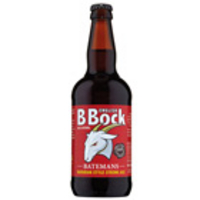Batemans B Bock, Batemans
Added: Friday, November 1st 2013
| Style | Bock | ABV 6.0% |
Bateman’s B Bock
Bateman’s of Wainfleet in Lincolnshire, a family brewery dating from 1874, has scored a remarkable victory: winner for the second year in succession of Sainsbury’s Beer Challenge. The award means the new beer, B Bock, will be available in all Sainsbury’s stores nationwide.
The brewery is in an idyllic location, its ivy-covered buildings -- including a windmill that used to grind the grain for brewing – alongside Salem Bridge that crosses the River Steeping. There’s a possible link to Salem in Massachusetts, infamous for its trials of alleged witches in the 17th century. Many of the founding fathers of the United States came from eastern England and may have taken the name Salem, along with Boston, with them.
The brewery, founded by George Bateman, is now run by brother and sister Stuart and Jaclyn. While such traditional cask beers as XB and XXXB remain the bedrock of the brewery, Stuart and Jaclyn, with head brewer Martin Cullimore, have developed a number of new brands in recent years, including the popular Yella Belly Gold, in order to reach out to a new and younger audience.
B Bock is a major departure, an English interpretation of a famous German beer style. Bock is best known for its associations with Munich and Bavaria, where it’s brewed as strong lager beer in several styles according to the season of the year, such as Maibock for the spring, a dark Bock for the winter or a strong Doppelbock (Double Bock), historically brewed by monks for the Lenten period as known as “liquid bread”.
The Bateman’s interpretation is called a strong ale, which may raise a few eyebrows. But not all Bock beers are made by the lager method and it may have originally been an ale from its inception in the 14th and 15th centuries. The style owes its origins to the old Saxon town of Einbeck, close to Hamburg and Brunswick. Einbeck was a member of the Hanseatic League that traded with other European cities and states as well as Scandinavia. Every member of the league had its own speciality and Einbeck’s was beer.
There are records of beer being brewed in Einbeck in 1378. It was a period when citizens were only allowed to brew if they had authority from the local duke. The brewing vessels were owned by the community and were passed from house to house. The order in which the vessels were deployed was the result of an auction on 1 May every year – a procedure that gave rise to the term May beer.
Beer that was not consumed in the town was exported through Hamburg and Bremen. Einbeck became rich as a result and was known in Saxony as “beer town”. Its products were known, in the Germanic fashion, as Einbecker beers. In his Beer Companion, Michael Jackson suggests that the early beers from the town may have been wheat beers, made by warm fermentation. This is entirely possible but lagering or cold conditioning of beer is much older than many people imagine.
When I visited the famous brewing town of Bamberg in Franconia and suggested to one brewer that prior to the invention of ice-making machines in the 19th century Bamberg brewers would have made wheat beers or other styles of ale, he disagreed. Lagering had gone on for centuries, he said. The brewers cut ice from the local river and even imported it by boat from Finland. Blocks of ice were placed in rooms above the lager cellars, where the beer stayed cold during several months of ageing. Einbeck is closer to Finland and Scandinavia than Bamberg and ice could have been imported through Hamburg and Bremen. Beer could also have been stored in caves in the local Harz mountains.
The association of Bock beer with Bavaria came about when the Duke of Brunswick married the daughter of a Bavarian aristocrat in the 17th century. The duke either took supplies of Einbecker beer with him to Munich or his court brewer went with him and brewed a special batch in the Bavarian capital. The locals were captivated by the beer and Munich brewers started to copy it. In the local dialect, Einbecker was rendered as “Oanbocker” and over time this was reduced simply to Bock. The word means billy goat in German and, as a sign of strength and virility, the symbol was used on the labels of Bock beer. The style was most closely associated with the monastic breweries in Bavaria. The Paulaner brewery in Munich was founded in 1634 by followers of St Francis of Paula. The monks made a strong Bock beer called Salvator (Saviour) and other monasteries followed suit.
While German Bocks are lager beers today, strong, malt-dominated beers called Bock are brewed in other countries by warm fermentation. In the Netherlands, the style is spelt “Bok” and one well-known example comes from the small craft brewery IJ, based in a windmill in Amsterdam.
Martin Cullimore’s Bock has a complex malt bill of Pilsner, Munich, cara, chocolate, crystal and black malts. The single hop used is Hallertauer Tradition. The beer has a colour rating of 50 and 24 units of bitterness. The deep copper/amber beer has a rich and enticing aroma of raisin and sultana fruit, smoked malt, fresh tobacco and floral hops. Ripe malt, dark fruit and gentle hops coat the tongue and the finish is long and quenching, with a fine balance of sweet, biscuit malt, rich fruit and light hops.
The beer costs £2.09 from branches of Sainsbury’s.







